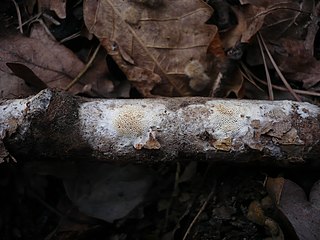
The Polyporaceae are a family of poroid fungi belonging to the Basidiomycota. The flesh of their fruit bodies varies from soft to very tough. Most members of this family have their hymenium in vertical pores on the underside of the caps, but some of them have gills or gill-like structures. Many species are brackets, but others have a definite stipe – for example, Polyporus badius.
Abundisporus is a small genus of poroid fungi currently with seven recognized species. They differ from other polypores in having coloured rather than hyaline spores.

The Fomitopsidaceae are a family of fungi in the order Polyporales. Most species are parasitic on woody plants, and tend to cause brown rots. The name comes from Fomitopsis + -aceae.

The Meruliaceae are a family of fungi in the order Polyporales. According to a 2008 estimate, the family contains 47 genera and 420 species. As of April 2018, Index Fungorum accepts 645 species in the family.

Auriporia is a small genus of four species of poroid fungi in the family Fomitopsidaceae.

Fomitopsis is a genus of more than 40 species of bracket fungi in the family Fomitopsidaceae.

Haploporus is a genus of poroid fungi in the family Polyporaceae.

Antrodia is a genus of fungi in the family Fomitopsidaceae. Antrodia species have fruit bodies that typically resupinate, with the hymenium exposed to the outside; the edges may be turned so as to form narrow brackets. Most species are found in temperate and boreal forests, and cause brown rot.

Meruliopsis is a genus of poroid crust fungi. The genus was circumscribed by Russian mycologist Appollinaris Semenovich Bondartsev in 1959.

Gloeoporus is a genus of crust fungi in the family Irpicaceae. The genus has a widespread distribution.

Ceriporiopsis is a genus of fungi in the family Phanerochaetaceae. The genus is widely distributed, and, according to a 2008 estimate, contains about 25 species. Ceriporiopsis was circumscribed in 1963 by Polish mycologist Stanislaw Domanski. The genus is a wastebasket taxon, containing "species that share common macroscopic and microscopic characteristics, but are not necessarily related." Ceriporiopsis species are crust fungi that cause a white rot. They have a monomitic hyphal system, containing only generative hyphae, and these hyphae have clamp connections.

Ceriporia is a widely distributed genus of crust fungi.

Antrodiella is a genus of fungi in the family Steccherinaceae of the order Polyporales.
Gelatoporia is a fungal genus in the family Gelatoporiaceae. This is a monotypic genus, containing the single widely distributed species Gelatoporia subvermispora. The genus was circumscribed in 1985 by Finnish mycologist Tuomo Niemelä to contain poroid crust fungi with a monomitic hyphal structure, clamped hyphae, and producing white rot.

Aurantiporus is a genus of poroid fungi in the family Meruliaceae. Circumscribed by American mycologist William Alphonso Murrill in 1905, the genus contains five species found mostly in northern temperate regions. Molecular analysis of several Aurantiporus species suggests that the genus is not monophyletic, but some other related polypore species need to be sequenced and studied before appropriate taxonomic changes can be made. In 2018, Viktor Papp and Bálint Dima proposed a new genus Odoria to contain Aurantiporus alborubescens based on multigene phylogenetic analyses. The generic name is derived from the Latin aurantius ("orange") and the Ancient Greek πόρος (pore).

Dentocorticium is a genus of six species of poroid fungi in the family Polyporaceae. The genus was revised in 2018, with several new species added and some older species transferred to other genera, based on phylogenetic analyses.

Skeletocutis is a genus of about 40 species of poroid fungi in the family Polyporaceae. The genus has a cosmopolitan distribution, although most species are found in the Northern Hemisphere. It causes a white rot in a diverse array of woody substrates, and the fruit bodies grow as a crust on the surface of the decaying wood. Sometimes the edges of the crust are turned outward to form rudimentary bracket-like caps.
Fibroporia bohemica is a species of poroid crust fungus in the family Fomitopsidaceae.
Amyloporia is a genus of five species of crust fungi in the family Polyporaceae. Its main distinguishing characteristic is the amyloid reaction of the skeletal hyphae, although some authors do not consider this to be sufficient to distinguish Amyloporia from the related genus Antrodia.
Ungulidaedalea is a fungal genus in the family Fomitopsidaceae. The genus was circumscribed by Chinese mycologists in 2016 to contain the single species Ungulidaedalea fragilis, a fungus that was described as new in 2014 with the name Fomitopsis fragilis. The holotype of this fungus was collected in Jianfengling Nature Reserve, in Ledong County (Hainan). The generic name Ungulidaedalea refers to the resemblance between this species and Daedalea, and also to the hoof-shaped (ungulate) form of the fruit body. Ungulidaedalea fragilis has rather fragile fruit bodies with a dark brown crust and large angular pores on the cap underside. Microscopic characteristics include its densely septated skeletal hyphae, and oblong-ellipsoid spores that measure 4–5.2 by 2.2–2.8 μm.














